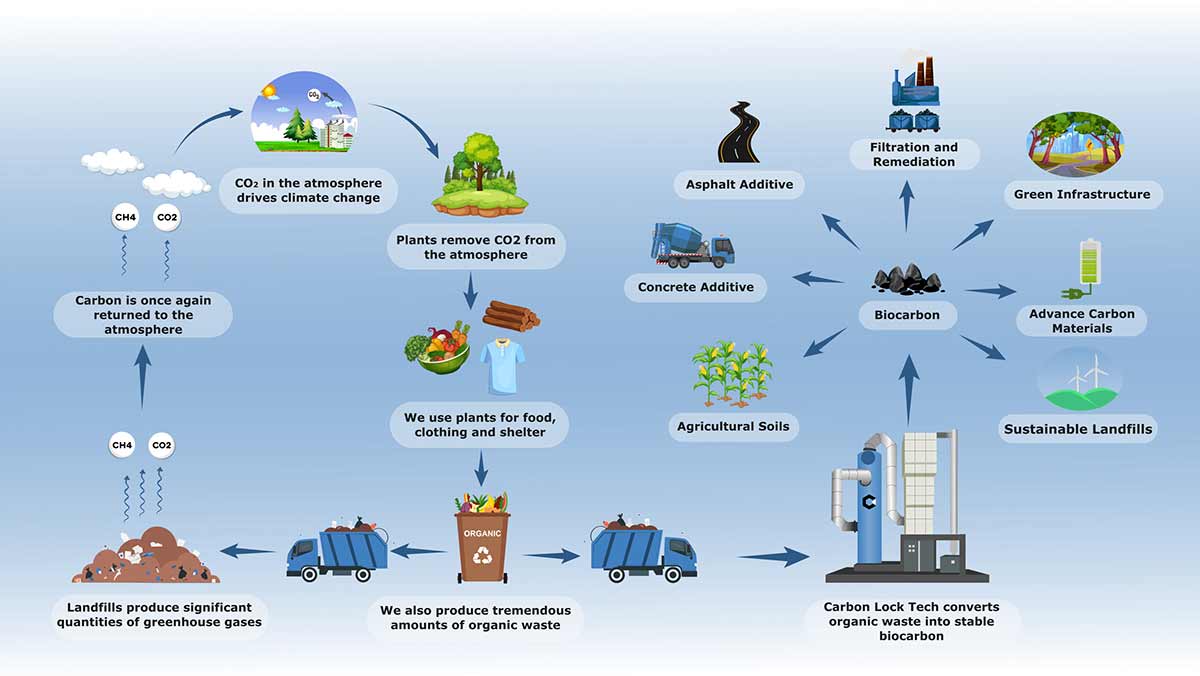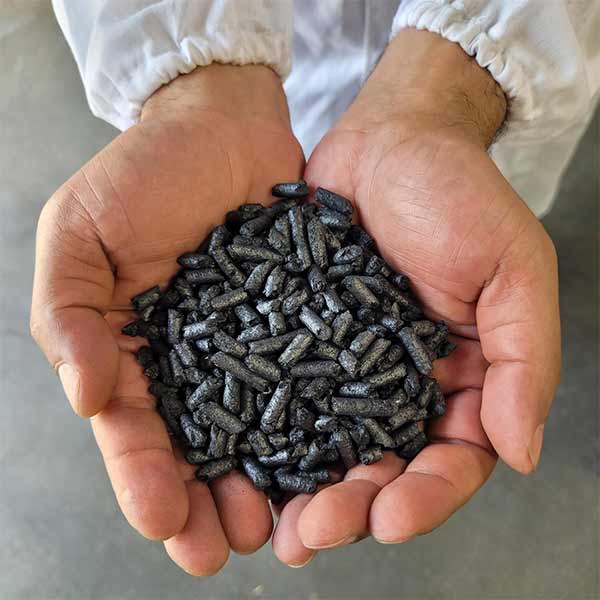Among the numerous global challenges we face, one challenge is particularly pressing – the extreme accumulation of carbon dioxide in the atmosphere.
Without adequate CO2 reduction and removal techniques, Earth is bound to become dangerous and uninhabitable in certain areas. Even now, impacts like extreme weather, widespread extinction, and social, economic, and political breakdown are already starting to happen and are expected to worsen.
For these reasons, we need trailblazing companies and professionals to step in and affect change on a global scale.
Startup Carbon Lock Tech, helmed by Kevin Danner, has answered the call and is working to develop the technologies to help slow down and reverse the negative outcomes associated with CO2 accumulation.
In this company profile, we will take a deep dive into Carbon Lock Tech’s journey from start-up to the present. We’ll cover the founding story, the mission, values, and mechanisms that drive Carbon Lock, their international expansion, the science behind carbon dioxide removal, and much more.
The Opportunity Hidden in Organic Waste
At its core, Carbon Lock Tech is a cleantech startup that uses an innovative, nature-based solution for removing carbon from the atmosphere and locking it away. But that’s just the tip of the iceberg.
Organic waste, fossil fuel combustion, deforestation, and livestock farming result in an excess of carbon in the atmosphere.
Why is this important? Think about the carbon cycle. Plants absorb carbon dioxide and expel oxygen. The animals then take in that oxygen and release carbon dioxide. This cycle has been self-balancing for hundreds of thousands or years, but that’s no longer the case as greater and greater amounts of carbon dioxide are being added to the atmosphere each year.
Fortunately, a good portion of that carbon is absorbed through photosynthesis and is stored in plants’ leaves, branches, seeds, fruits, and roots. That same carbon then circulates through our economy in the form of products and consumables like food, textiles, clothing, and other organic materials.
But when we are done using these materials, much of it ends up decaying in a landfill as waste. As it decomposes, methane (which is 25x more potent than carbon), is released into the atmosphere. Methane may also be released when plants die.

Using a patented pyrolytic reactor system, Carbon Lock Tech intercepts this waste carbon and transforms it into biocarbon, which reduces methane formation. This biocarbon can then be used as a soil amendment, incorporated into cement-based materials, or used for reclamation projects. In these applications, the biocarbon works to lock away carbon from the atmosphere and reduce downstream emissions.
Carbon Lock leverages a method that the Canadian government recognizes as a viable solution in “Capturing the Opportunity: A Carbon Management Strategy for Canada.” Per the strategy, proper carbon management involves “CDR (carbon dioxide reduction) approaches that remove CO2 from the atmosphere and store it durably in natural carbon reservoirs, such as rock formations, soils, plants, oceans, or long-lived products.”
The goal is to help the world reach net zero by 2050 and avert the worst of the climate crisis.
The journey from initial concept to international venture

Carbon Lock Tech founder and CEO Kevin Danner first became engaged with the issue of climate change in the late 1980s while taking a course on international efforts to address the ozone layer issue. He followed up with additional studies into evidence-based decision making before pursuing a career in government. Kevin worked as a risk manager and policy analyst for the Department of Natural Resources Canada and the Department of Fisheries and Oceans Canada and then as a policy advisor for the Manitoba government on the Made-in-Manitoba Climate and Green Plan.
Throughout his tenure, he has focused on climate change and carbon management. But after becoming frustrated with the slow progress toward achieving net-zero and Paris climate commitments, he needed to make a change. He then left the government sector, co-founded Carbon Lock Tech, and began to develop systems and technologies for converting organic matter into stable biocarbon and sequestering it away for good.
The idea of focusing on biocarbon (sometimes called “biochar”) that eventually grew into Carbon Lock Tech started with the UN Climate Change Conference COP21 and the Paris Agreement. While watching the conference, he heard the French AG minister mention “biochar.” Soon after, he began researching the topic further to find out more about the carbon offsetting made possible simply by putting more carbon in the soil.
Testing Process
Danner then bought some biochar for home use, successfully grew some plants, and was approached by a curious neighbour, whose uncles had designed and built a simple backyard kiln that could make biochar. “I still have it [the machine] at the farm. Do you want it?” the neighbour offered.

Ramping Up
Danner accepted the machine and, with co-founder Terry Gray, began making biochar in his backyard. They eventually brought on investors and hired a few engineers under the ECO Canada program and the NRC Industrial Research Assistance Program. Together the team designed and built a continuous model, secured a patent, and completed a pilot project. Through grant funding, they were able to hire more engineers.
Stepping into international expansion
Today, Carbon Lock Tech is advancing its technology and work with mining companies and concrete companies to explore sustainable applications for “locking” the carbon away. They are also searching for commercial partners, collaborating with international companies, and looking to participate in the carbon dioxide removal credit market. In fact, the company is in talks with a Silicon Valley carbon dioxide removal organization that’s considering signing a CDR credit agreement.
This would be the very first agreement, and the team expects to see more and more of these over time.
This business venture hasn’t gone unnoticed. Carbon Lock Tech won the Startup Canada Pitch event earlier this year, and are set to compete live against nine other finalists for $70,000 this October.
Current challenges and goals for the future
Carbon Lock Tech is an international startup creating technologies and carbon removal services for a global market. So, it’s crucial to get a good handle on navigating global trading systems, complex business landscapes, and diverse cultures. In addition to that, there are other challenges to consider.
Building a cleantech startup isn’t easy by a long shot, and it takes a considerable amount of time and sustained hard work to take a venture from a concept to a profitable company. But the biggest challenges arise when one or more of the following factors is missing:
- Access to smart, patient capital.
- Support from funding programs and stable government policies.
- Market demand from end users.
As for the goals going forward, it’s all about scale and impact.
“From here, we are looking to scale this to the megaton scale. And then, who knows, eventually the gigaton scale, which is where the world has to get if we want to make it to net zero by 2050.”
As you can see, the goal is to make substantial change on a global scale.
A primer on Carbon Dioxide Removal (CDR) credits and how they work
Carbon dioxide removal (CDR) credits are service exports where a company sells the service of carbon removal to firms in other companies or governments around the world. These buyers seek to purchase such credits in order to offset their own emissions or meet climate targets.
CDR credits are similar to traditional carbon credits, which have been in existence for about 20 years, since the Kyoto Protocol, which worked to encourage innovation and efficiency by facilitating emissions trade within a cap-and-trade system or a government-regulated compliance market. The difference is the CDR credits can only be generated and sold by systems or technologies that remove carbon from the atmosphere, as opposed to emissions reductions or avoidance practices. It’s a distinction that makes a major difference, because there is no way to reducing the total amount of carbon already in the atmosphere other than carbo dioxide removal.
Today, the CDR credit market is a voluntary market where businesses that want to reach net zero can purchase credits from carbon removal businesses. Unlike cap-and-trade and government-regulated markets, the voluntary market is only a few years old – major tech players like Google, Microsoft, Shopify and Facebook participate strongly in this market.
Companies typically pre-buy CDR credits as either an offtake agreement or advanced market commitment. They sometimes pay for the credits upfront so that the CDR companies can accelerate their technologies – they then enjoy priority access to the first credits produced.

Carbon removal certification and government intervention
Puro.earth is a Finland-based registry that certifies carbon removal suppliers according to their “Puro Standard.” NASDAQ just bought the company, so stock markets are getting involved.
These international markets exist without relying on national policies or structures. So, any Canadian company could generate CO2 removal credits and sell them to any other company, or country, regardless of their location. Therefore, this is a market mechanism as well as a service export.
Kevin Danner weighs in on standardization in this area, saying that, “if governments are able to create the policy framework around this to bring more standardization, more rigor, I believe that will strengthen the markets, and that’s already happening in Europe and to some extent in the U.S.”
Though policy isn’t necessary for scaling up in this industry, standardized government frameworks could be beneficial. It could enable the integration of funding across agriculture and economic development, as well as Environment and Climate Change Canada.
Building a policy infrastructure in the carbon dioxide removal space could position Canada as a trusted provider of sequestered carbon and bring substantial revenue to the country from the production and sale of carbon credits.
The international sale of carbon credits
Selling carbon credits internationally can be complex, given the variety of markets, regulations, and types of credit systems. Certain regions have cap-and-trade mechanisms. Others have internal compliance markets. Still others are developing credit registries that act as clearinghouses – once credits are registered, they can be purchased and retired, preventing resale and ensuring no double-counting. These latter are important, because while small-scale transactions can be easy and informal, large-scale carbon transactions require formal registries and life cycle analyses. These analyses evaluate:
- Feedstock origin
- Transportation emissions
- Sequestration timeframes
- Technology verifications
A proper registry ensures that the credits reflect the actual amount of carbon sequestered.
Reporting and verification: Registries require rigorous reporting and verification to maintain the quality of biocarbon production, including sample validation and machinery checks.
Carbon accounting: Carbon accounting firms help companies measure their emissions and balance them with credits to achieve sustainability goals.
Government requirements: Governments may soon mandate companies to register and report carbon usage. Proactive companies are already building a pipeline of credits to comply with anticipated regulations.
Planning for different domestic and export markets
Carbon Lock Tech sees the potential markets and product adaptations that could be on the horizon.
Like dollars, carbon credits are meant to be “fungible.” This makes for more straightforward transactions. Still, there will be projects that command a higher premium.
One example would be companies that work with a First Nation community to convert their waste into carbon and use it for water filtration. In this case, green jobs are created, and sustainable development goals are met. These projects will attract companies interested in both carbon credits and the ESG aspect.
Here’s another example – setting up a carbon removal facility in the Amazon could help the local community preserve their forest by helping them develop an alternative source of incomes – carbon removal credits. Forward-looking companies would be willing to pay a premium for such impacts that extend beyond carbon offsetting.
The challenge for Carbon Lock Tech will be in creating an effective export plan from assessing their target market to positioning themselves for a competitive advantage, and crucially, identifying relevant legal and regulatory issues.
Carbon Lock Tech is at the forefront of a global solution for climate change
To date, much of the focus on addressing climate change has been in the area of emissions reductions. This is critically important and needs to be a priority at every level of government. At the same time, the concept of carbon removal allows us to address the climate issue head on, turning turn what would have been a risk into an opportunity. And the Carbon Lock Tech team is working to bring this opportunity to reality.
“In Canada we have a major advantage,” says Danner. “We have the knowledge, the technologies, the people, the resources, and the land. We can play a major role at the forefront of carbon dioxide removal, developing an entirely new industry capable of removing and sequestering gigatons of carbon, right here in Canada, and generating international revenues from it – if we do this right.”







disqus comments